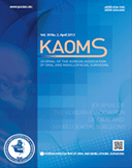Journal of the Korean Association of Oral and Maxillofacial Surgeons
- P-ISSN2234-7550
- E-ISSN2234-5930
- SCOPUS, KCI, ESCI
 ISSN : 2234-7550
ISSN : 2234-7550
The effects of high-fat diet on implant osseointegration: an experimental study
Ferhan Yaman (Dicle University)
Muhammed Fatih Ozupek (Inonu University)
Arif Saybak (Private Practice)
Mehmet Gul (Dicle University)
Fatih Asutay (Afyon Kocatepe University)
Mustafa Kirtay (Inonu University)
Ibrahim Hanifi Ozercan (Firat University, Elazig)
Abstract
Objectives: In this study, we investigated whether a high-fat diet (HFD) affected the bone implant connection (BIC) in peri-implant bone. Materials and Methods: Four male rabbits were used in this study. Dental implant surgery was introduced into each tibia, and four implants were integrated into each animal. In both the normal diet (ND) group (n=2) and HFD group (n=2), 8 implants were integrated, for a total of 16 integrated implants. The animals continued with their respective diets for 12 weeks post-surgery. Afterward, the rabbits were sacrificed, and the BIC was assessed histomorphometrically. Results: Histologic and histomorphometric analyses demonstrated that BIC was not impaired in the HFD group compared to the ND group. Conclusion: Within the limitations of this study, we found that HFD did not decrease the BIC in rabbit tibias.
- keywords
- Bone implant contact, Osseointegration, Titanium implants, High-fat diet, Histomorphometric analysis
- 다운로드 수
- 조회수
- 0KCI 피인용수
- 0WOS 피인용수